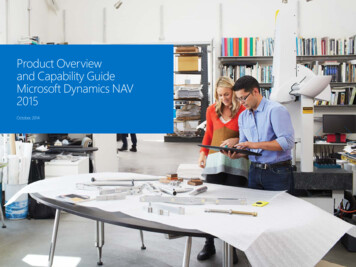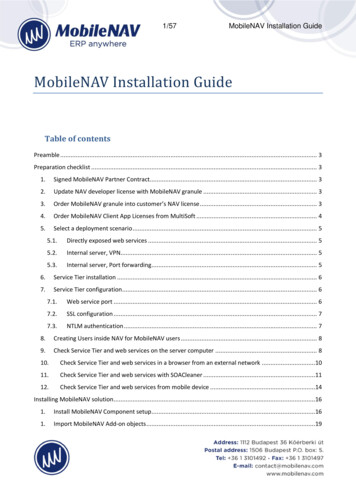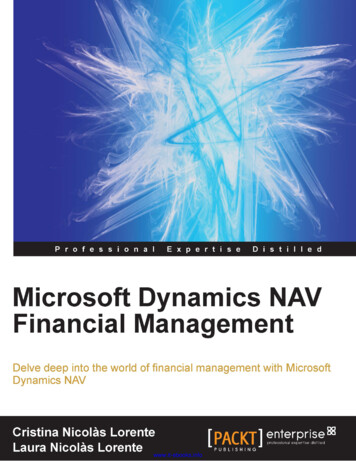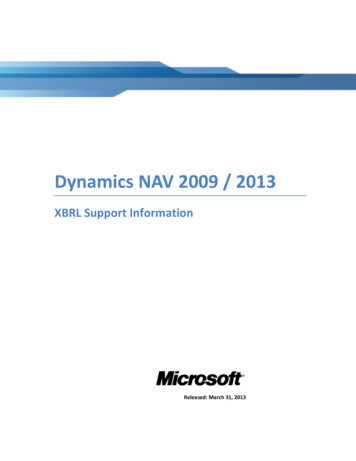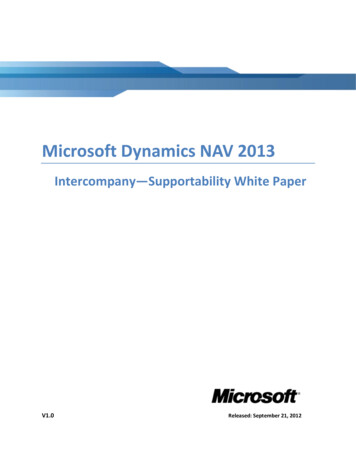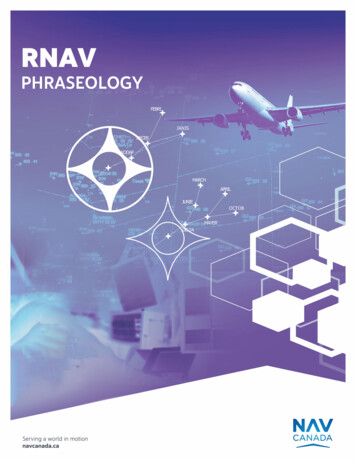
Transcription
RNAVPHRASEOLOGYnavcanada.ca
2020 NAV CANADA.All rights reserved. No part of this document may be reproduced in any form, including photocopying or transmission electronicallyto any computer, without prior written consent of NAV CANADA. The information contained in this document is confidential andproprietary to NAV CANADA and may not be used or disclosed except as expressly authorized in writing by NAV CANADA.NAV CANADA would like to thank all those from across the industrythat contributed to the creation of this document.Version 1.0, June 2020Questions, comments and feedback can be directed to: service@navcanada.ca.RNAV PHRASEOLOGY
RNAVPHRASEOLOGYContentsIntroduction . 1Terminology. 3Icons . 4Typographic Conventions . 4RNAV STAR . 5Features . 5Pilot Actions under an RNAV STAR Clearance . 5DESCEND . 5DESCEND – Cancellation of Altitude Restriction . 6DESCEND – Cancellation of Speed Restriction . 6DESCEND UNRESTRICTED – Cancellation of All Remaining Altitude and Speed Restrictions . 6RNAV STAR–Altitude Clearance . 7DESCEND . 7DESCEND with Tactical Cancellation of Altitude Restriction . 8DESCEND with Tactical Cancellation of Speed Restriction. 8DESCEND UNRESTRICTED – Cancellation of All Remaining Altitude and Speed Restrictions . 9Proceed Direct to a Point on a STAR . 10Proceed Direct to a Point (which is an approach interface waypoint) on a STAR . 11Vector Flight off an RNAV STAR then Re-establishment on the Same STAR Transition . 13RNAV STAR – Change of Transition . 15Termination of Vectoring between Waypoints for RNAV STAR . 16General – RNAV (GNSS) Approach . 17Features . 17navcanada.ca
General - RNAV (GNSS) ILS Approach . 18Features .18General - RNAV RNP Approach . 19Features . 19RNAV STAR to RNAV (GNSS) Approach (STAR with an approach interface waypoint) . 20RNAV STAR to RNAV (RNP) Approach (STAR with an approach interface waypoint) . 21Direct Route to an Approach IF/IAWP/IWP (Non-STAR Scenario) . 22Pilots Notifying ATC of Requested Approach Procedure . 23Pilots Notifying ATC of an Inability to Conduct an Approach Procedure . 24RNAV SID . 25Features . 25Pilot Action under an RNAV SID Clearance . 25CLIMB . 25CLIMB – Cancellation of Altitude Restriction.26CLIMB – Cancellation of Speed Restriction .26CLIMB UNRESTRICTED – Cancellation of All Remaining Altitude and Speed Restrictions .26RNAV SID–Altitude Clearance . 27CLIMB . 27CLIMB with Tactical Cancellation of Altitude Restriction .28CLIMB with Tactical Cancellation of Speed Restriction .28CLIMB UNRESTRICTED – Cancellation of All Remaining Altitude and Speed Restrictions .29Proceed Direct to a Point on a SID . 30Vector Flight off an RNAV SID Then Re-establishment on the Same SID Transition . 31Change RNAV SID Transition . 32Termination of Vectoring between Waypoints for RNAV SID . 33RNAV PHRASEOLOGY
IntroductionAs the air navigation system in Canada becomes more modernised through the use ofPerformance-Based Navigation (PBN) instrument flight procedures, Air Traffic Services (ATS) andIndustry stakeholders require an alignment and standardisation of procedures and phraseologyfor PBN operations. As a key enabler of PBN, RNAV-based instrument departure and arrivalprocedures are being developed and published across the entire Canadian airspace system.TheRNAV Phraseology Guide has been created by NAV CANADA through extensive consultationand collaboration between ATS and key Airline Operators. The guide is intended to be used byATS personnel and pilots as a means to provide a description of how RNAV SID, STAR andinstrument approach procedures are flown, as well provide a common source for thephraseology to be used by ATS and pilots for these procedures.This Guide is to be used as guidance for ATS and pilots, and is intended to supplement directioncontained in the NAV CANADA Manual of Air Traffic Services (MATS) as well as in theTransport Canada Aeronautical Information Manual (TC AIM).navcanada.ca1
2RNAV PHRASEOLOGY
TerminologyIAWP or IAFInitial Approach Waypoint or Initial Approach FixIWP or IFIntermediate Waypoint or Intermediate FixFACFFinal Approach Course FixFAWPFinal Approach WaypointFLY-BY WAYPOINTA waypoint that requires the use of turn anticipation to avoid anovershoot of the next route segment.FLY-OVER WAYPOINTA waypoint that precludes any turn until the waypoint is overflownand is followed by an intercept manoeuvre of the next route segment.TRANSITIONA published procedure used to connect the basic SID to one or more enroute airways, toconnect one or more enroute airways to the basic STAR, or to connect an IF or IAWP to the finalapproach course of an RNAV or ILS approach. More than one transition may be published in theassociated SID, STAR, or RNAV approach.APPROACH INTERFACE WAYPOINTWaypoint common to an RNAV STAR and an instrument approach. It allows the linking of thetwo procedures after an approach clearance is received from ATC.navcanada.ca3
IconsNoteSupplementary informationPhraseologyThe rules for constructing the appropriate phraseology (syntax) for useby air traffic servicesExampleAn example of how phraseology might be spoken by air traffic servicesPilot Phraseology The rules for constructing the appropriate phraseology (syntax) for useby pilotsPilot ExampleAn example of how phraseology might be spoken by pilotsTypographic ConventionsIn the rules for constructing phraseology, some characters have special meaning:UPPERCASEIndicates words that are to be spoken exactly as writtenlowercaseDescribes variable information- hyphensbetween lettersInserted between letters, indicate that they are to be spoken individually( ) parenthesesGroups information for clarity[ ] square bracketsSurrounds optional information that may be necessary in specific instances/ slashSeparates alternative information in a phrase; only one of the alternates isused4RNAV PHRASEOLOGY
RNAV STARFeaturesAn RNAV STAR is an assembly of successive route segments leading to a location where atransition to an approach is possible. The transition could be an approach interface waypointcommon to the STAR and the approach procedure or a location where a radar vector to theapproach is normally provided.An altitude and/or speed restriction can be associated to an RNAV STAR waypoint.Onboard Flight Management Computers (FMC) automate the aircraft lateral and verticalnavigation based on the waypoint location and charted altitude/speed restrictions.Pilot Actions under an RNAV STAR ClearanceDESCEND Follow the lateral path of the STAR procedure Unless “when ready” is part of the clearance, descend now to the ATC clearedaltitude while complying with the STAR-charted altitude restrictions at or above thecleared altitude and additional ATC altitude restrictions, if any Comply with the STAR-charted airspeed or the ATC-assigned speed restriction, ifany. Comply with speed in the following priority:1.CARs 602.32 Airspeed Limitations2.ATC assigned speed3.Charted speednavcanada.ca5
DESCEND – Cancellation of Altitude Restriction Follow the lateral path of the STAR procedure Unless “when ready” is part of the clearance, descend now to the ATC clearedaltitude while complying with the STAR-charted altitude restrictions at or above thecleared altitude except for the cancelled altitude restrictions Comply with the STAR-charted airspeed or the ATC-assigned speed restriction, ifany. Comply with speed in the following priority:1.CARs 602.32 Airspeed Limitations2. ATC assigned speed3. Charted speedDESCEND – Cancellation of Speed Restriction Follow the lateral path of the STAR procedure Unless “when ready” is part of the clearance, descend now to the ATC cleared altitudewhile complying with the STAR-charted altitude restrictions at or above the clearedaltitude and additional ATC altitude restrictions, if any Comply with the STAR-charted airspeed restrictions except for the cancelled speedrestrictions. Comply with speed in the following priority:1.CARs 602.32 Airspeed Limitations2. ATC assigned speed3. Charted speedDESCEND UNRESTRICTED – Cancellation of All Remaining Altitude andSpeed Restrictions Follow the lateral path of the STAR procedure Descend now to the ATC cleared altitudeAll STAR altitude and speed restrictions between the aircraft’s current altitude and thecleared altitude no longer apply.6RNAV PHRASEOLOGY
RNAV STAR–Altitude Clearance130001100010000Figure 1 RNAV STAR–Altitude ClearanceDESCENDPhraseology( aircraft id ) DESCEND [ TO ] ( altitude )ExampleINUIT ONE-TWO-THREE DESCEND TO ONE-ZERO THOUSAND.Pilot Actions Begin the descent to the ATC-cleared altitude Comply with the altitude and speed restrictions charted on the STAR Comply with speed in the following priority:1.CARs 602.32 Airspeed Limitations2. ATC assigned speed3. Charted speednavcanada.ca7
DESCEND with Tactical Cancellation of Altitude RestrictionPhraseology( aircraft id ) DESCEND [ TO ] ( altitude )ALTITUDE RESTRICTION AT ( waypoint ) CANCELLEDExampleWESTJET ONE-TWO-THREE DESCEND TO ONE-ZERO THOUSAND ALTITUDERESTRICTION AT ZABEL CANCELLED.Pilot Actions Begin the descent to the ATC-cleared altitude Comply with the altitude and speed restrictions charted on the STAR with theexception of the altitude restriction at ZABEL Comply with speed in the following priority:1.CARs 602.32 Airspeed Limitations2. ATC assigned speed3. Charted speedDESCEND with Tactical Cancellation of Speed RestrictionPhraseology( aircraft id ) DESCEND [ TO ] ( altitude )SPEED RESTRICTION AT ( waypoint ) CANCELLEDExampleWESTJET ONE-TWO-THREE DESCEND TO ONE-ZERO THOUSANDSPEED RESTRICTION AT ZABEL CANCELLED.Pilot Actions Begin the descent to the ATC-cleared altitude Comply with the altitude and speed restrictions charted on the STAR with theexception of the speed restriction at ZABEL8RNAV PHRASEOLOGY
DESCEND UNRESTRICTED – Cancellation of All Remaining Altitude andSpeed RestrictionsPhraseology( aircraft id ) DESCEND UNRESTRICTED [ TO ] ( altitude )ExampleWESTJET ONE-TWO-THREE DESCEND UNRESTRICTED TO ONE-ZERO THOUSAND.Pilot Action Begin an unrestricted descent now to the ATC-cleared altitude.All STAR altitude and speed restrictions between the aircraft’s current altitude and thecleared altitude no longer apply.navcanada.ca9
Proceed Direct to a Point on a STARGAUTIRNAV (GNSS)RWY 28ALWAR103 RABUV32DUNUP(6)220 ktRUDSU40002700220 kt010 2700)6 (8PENPARwy 28103 (10)283 4000Trk282 282 042(6) Rwy 10TrkALMIV9000(7)010 EBDOT11000(14)010 (230 kt)010 LATTS11000Figure 2 Direct to a PointPhraseology( aircraft id ) PROCEED DIRECT ( waypoint name ) REJOIN STARExampleAIR CANADA ONE-TWO-THREE PROCEED DIRECT PENPA REJOIN STAR.Pilot Actions Proceed direct to PENPA Comply with all charted altitude and speed restrictions at and after PENPAThe pilot is not required to comply with the published altitude or speed restrictions atwaypoints being bypassed.10RNAV PHRASEOLOGY
Proceed Direct to a Point (which is an approach interfacewaypoint) on a STARFigure 3 STAR Way PointFigure 4 Approach Waypointnavcanada.ca11
The STAR may include an approach interface waypoint common to the STAR and the approachprocedure. In such cases, the navigation system displays the waypoint twice: in the STARwaypoint list and in the approach waypoint list. If the controller instructs the pilot to proceeddirect the approach interface waypoint, the pilot is expected to select it from the STAR waypointlist to prevent the aircraft from flying the lateral profile of the approach without clearance.Phraseology( aircraft id ) PROCEED DIRECT ( waypoint name ) REJOIN STARExampleAIR CANADA ONE-TWO-THREE PROCEED DIRECT DUTIR REJOIN STAR.Pilot Actions Proceed direct to DUTIR, selected from the STAR waypoint list Comply with all charted altitude and speed restrictions at and after DUTIR12RNAV PHRASEOLOGY
Vector Flight off an RNAV STAR then Re-establishment onthe Same STAR TransitionGAUTIALWARRNAV (GNSS)RWY 28103 RABUV32DUNUP(6)220 ktRUDSU40002700220 kt010 2700)6 (8PENPARwy 28103 (10)283 4000Trk282 282 042(6) Rwy 10TrkALMIV9000(7)010 EBDOT11000(14)010 (230 kt)010 LATTS11000Figure 5 Vector Off then Re-establishnavcanada.ca13
Phraseology( aircraft id ) VECTORS FOR ( reason ) FLY HEADING / TURN RIGHT / LEFT HEADING( number )EXPECT DIRECT ( waypoint name ) IN ( number ) MILESRejoin STAR( aircraft id ) PROCEED DIRECT ( waypoint name ) REJOIN STARExampleAIR CANADA ONE-TWO-THREE VECTORS FOR SEQUENCING TURN LEFT HEADINGTHREE-ONE-ZERO, EXPECT DIRECT ALMIV IN ONE-FIVE MILES.Rejoin STAR;AIR CANADA ONE-TWO-THREE PROCEED DIRECT ALMIV REJOIN STAR.Pilot Actions Turn the aircraft to the assigned heading Await clearance to proceed direct to ALMIV and retain the STAR in the navigationsystemWhen rejoining STAR, Proceed direct ALMIV to rejoin the STAR Comply with the remaining STAR charted restrictions including ALMIV.14RNAV PHRASEOLOGY
RNAV STAR – Change of TransitionPOLTYYXI.0)(40227 LETAK6 )2 4 09.0(11 2 5 7.9)TUKIR(7BETUL2PERGI(74.20 .0)(65227 25 58 )0 25 2.3)TADMO(23 2 4 .7)06(VIBLI2 50 )(3Original route clearanceRevised route clearance8.2KATIEFigure 6 Change RNAV STAR TransitionPhraseologyChange of STAR transition:( aircraft id ) RECLEARED ( procedure name ), ( transition name ),PROCEED DIRECT ( waypoint name ) REJOIN STARExampleChange of STAR transition:AIR CANADA ONE-TWO-THREE RECLEARED KATIE TWO ARRIVAL, POLTYTRANSITION, PROCEED DIRECT PERGI REJOIN STARPilot Actions Proceed direct PERGI to join the new STAR transition Comply with the STAR charted restrictions including PERGInavcanada.ca15
Termination of Vectoring between Waypoints for RNAVSTARGAUTIALWARRNAV (GNSS)RWY 28103 RABUV32RUDSU40002700DUNUP220 kt(6)010 2700220 kt)6 (8PENPARwy 28103 (10)283 4000Trk282 282 042(6) Rwy 10TrkALMIV9000(230 kt)010 LATTS11000Figure 7 Termination of Vectoring between WaypointsPhraseologyVector intercept of STAR( aircraft id ) FLY HEADING / TURN LEFT / RIGHTHEADING ( number ), REJOIN ( STAR name )ExampleVector intercept of STARAIR CANADA ONE-TWO-THREE TURN RIGHT HEADING ZERO-THREE-ZERO REJOINLATTS TWO ARRIVAL.Pilot Actions Maintain the assigned heading to join the STAR Comply with the remaining STAR charted restrictions16RNAV PHRASEOLOGY
0000SELPEDON00BL09 9 830RAT305601 5 N M TO HE30039 SE-BAHTGIR0 ()EAAR9 03A)REEASBAFT(LESGGJO WP)A(M9 12 35.RATHERMBLU WP)A(F9 12 06.0049 9 03 05.RATHE WP)A(I5200052 9 21 05.DONBL P)I( W P)W(IA21LS6052PEE084 TOMSELPE WP)(IABLONDTONM830MBLONDTO12N30NGeneral – RNAV (GNSS) ApproachA)REEASAT-BGH(RI30 NM TO HEATRFigure 8 RNAV (GNSS) Approach: HEATR, BLOND, PEELSFeatures IAWP: initial approach waypoint IWP: intermediate waypoint FAWP: final approach waypoint MAWP: missed approach waypointThe final approach course can be intercepted through three different “transitions”: HEATR, BLOND,or PEELS. All three are listed separately in the GPS/FMC and defined as follows:HEATR TransitionHEATRBLONDLUMBRJOGGSBLOND TransitionBLONDLUMBRJOGGSPEELS TransitionPEELSBLONDLUMBRJOGGSPilot ActionFly the RNAV approach fix sequence of the transition name included in the approach clearance.navcanada.ca17
General - RNAV (GNSS) ILS ApproachFigure 9 RNAV (GNSS) ILS Approach: BEMIG, MIPOT, OBSUKFeatures IAWP IWP/IF FACFThe final approach course can be intercepted through three different “transitions”: BEMIG,MIPOT, or OBSUK. All three are listed separately in the GPS/FMC and defined as follows:BEMIG TransitionBEMIGMIPOTDEVONMIPOT TransitionMIPOTDEVONOBSUK TransitionOBSUKMIPOTDEVONPilot ActionFly the approach fix sequence of the transition name included in the approach clearance.18RNAV PHRASEOLOGY
General - RNAV RNP Approach(IWP)KEMLU5000 210 ktRF Required3.63900203 TEFLY07260 233.100074.11 t.5MEBEP7.900ULAGU200 ktRW074.0(FAWP)AMOBI001 072.0171 23(IWP)VISOL300007170051.PESKI200 kt0015OMTIT0k1003002.9MOBAS2 214500251 32.(IWP)NOVUX5000 210 ktRF RequiredFigure 10 RNAV RNP Approach: NOVUX, VISOL, KEMLUFeatures IAWP: initial approach waypoint IWP: intermediate waypoint FAWP: final approach waypoint MAWP: missed approach waypointThe final approach course can be intercepted through three different “transitions”: NOVUX,VISOL, or KEMLU. All three are listed separately in GPS/FMC and defined as follows:NOVUX TransitionNOVUXILAGUMEBEPAMOBIRWY07VISOL TransitionVISOLMEBEPAMOBIRWY07KEMLU TransitionKEMLUMOBASOMTITPESKIAMOBIRWY07Pilot ActionFly the RNAV RNP approach fix sequence of the transition name included in the approachclearance.navcanada.ca19
RNAV STAR to RNAV (GNSS) Approach (STAR with anapproach interface waypoint)OMSOMNAGEK180 ULDOL300090 VOGIGNAGEK3000095 (5.0)210 kt3000275 (5.0)AVSUNSAXIV185 6.0CYA411(F)SFC TO 1500CONT DAYLIGHTEBLUN210 ktCYR405SFC TO 1800CONT185 4.0ORORK170 ktCYR409SFC TO 1300CONTLEPEMODBITBOTURGOPEDFigure 11 RNAV STAR to RNAV GNSS ApproachPhraseologySTAR to approach( aircraft id ) CLEARED ( RNAV approach name ) APPROACH ( runway id ) (approachtransition name ) TRANSITIONExampleSTAR to approachJAZZ ONE-TWO-THREE CLEARED RNAV ZULU RUNWAY ONE-EIGHT APPROACH,NAGEK TRANSITION.Pilot ActionsSTAR to approach Before NAGEK,——Follow the lateral path of the STAR procedureDescend and comply with the STAR charted altitude and speed restrictions if any From NAGEK,20—Join the approach at NAGEK—Follow the lateral and vertical profile of the RNAV approach procedureRNAV PHRASEOLOGY
RNAV STAR to RNAV (RNP) Approach (STAR with anapproach interface waypoint)1400010000 250 ktAPLEXRWY08LTrk263 SEBOG5800210 kt264 (IWP)NOTAVKISIP2900ONBOK2900083 2.600276 0 5.3.08132.7 0021005.0(IWP)EMKAM2100180 ktRNP 0.30083 43.71300(5)MILLS2390) 264 (1(4)(IAWP)SEBOG5800210 ktUKNOSRW08L083 YPK084 10.13.8083 DULKIBASRA264 (8)(200kt)2.6MIDVARNP 0.30(FAWP)BEXIMFigure 12 RNAV STAR to RNAV RNP ApproachPhraseology( aircraft id ) CLEARED ( RNAV approach name ) APPROACH ( runway id )( approach transition name ) TRANSITIONExampleSTAR to approachJAZZ ONE-TWO-THREE CLEARED RNAV YANKEE RUNWAY ZERO-EIGHT LEFTAPPROACH, SEBOG TRANSITION.Pilot ActionsSTAR to approach Before SEBOG,—Follow the lateral path of the STAR procedure—Descend and comply with the STAR-charted altitude and speed restrictions From SEBOG,—Join the approach at SEBOG—Follow the lateral and vertical profile of the RNAV approach procedurenavcanada.ca21
Direct Route to an Approach IF/IAWP/IWP (Non-STARScenario)LEROSLR3 XUBAG6.005-323YQX130LR-312 YQXODKAS3 5.03 2532 005. 3 0130 083 263 No PT1400 GANDER280 QX23R 006 . 6 -331NMDME Ch 7405.0IF XETAR14.4 DME (YQX)GANDER112.7 YQX6.72114 005 3 05LOPMAHOROW16 DME2200 TO IFRWY05 OBNOWFigure 13 Direct Route to an Approach IF/IAWP/IWP (HOROW and XETAR)Phraseology( aircraft id ) PROCEED DIRECT ( approach waypoint / fix name),CLEARED ( approach name ) ( runway id ) APPROACH [ ( transition name )TRANSITION ]ExampleWESTJET ONE-TWO-THREE PROCEED DIRECT HOROW, CLEARED RNAV ZULURUNWAY ZERO-FIVE APPROACH, HOROW TRANSITION.PORTER ONE-SEVEN-FIVE PROCEED DIRECT XETAR, CLEARED ILS RUNWAY ONETHREE APPROACH.Pilot Actions Follow the lateral path of direct trajectory to the approach waypoint/fix Descend not lower than a published minimum IFR altitude Fly the approach procedure starting at the approach waypoint/fix22RNAV PHRASEOLOGY
Pilots Notifying ATC of Requested Approach ProcedurePilots should plan their arrival based on the information on ATIS. Therefore, if RNAV is advertisedas the primary approach, ATC expects the aircraft to be set up for the RNAV approach.At some airports in Canada, more than one RNAV approach (RNAV GNSS or RNAV RNP) may beavailable for one or more runways. Based on this, the ATIS message at airports where multipleRNAV approaches are available must direct aircrews to inform ATC on initial contact of therequested approach procedure. ATC makes use of different control methods depending on thetype of approach—failing to communicate the requested approach on initial contact may resultin inefficient flight profiles, increased flying distances, and additional crew workload. Whenpilots inform ATC on initial contact of the requested approach, this assists ATC in planning andsequencing considerations, and reduces transmissions on the ATC frequency.At airports where Terminal Control service is provided and RNAV approach procedures arebeing advertised as the primary approach on ATIS, the ATIS message must request pilots toinform the Arrival controller on initial contact of their requested approach. At airports without adesignated Terminal or Arrival controller, the ATIS message may stipulate either an ATC unit or afrequency for pilots to inform ATC of their requested approach procedure.Pilot Actions Where multiple RNAV approaches are available, pilots must request their intendedapproach on initial contactPilot Phraseology( aircraft id ), REQUEST ( RNAV approach name ) APPROACH ( runway id )Pilot ExamplesWESTJET ONE-TWO-THREE FLIGHT LEVEL TWO-ZERO-ZERO FOR ONE-SIXTHOUSAND, INFORMATION DELTA, REQUEST RNAV YANKEE RUNWAY THREETWO.PORTER ONE-SEVEN-FIVE FLIGHT LEVEL TWO-ZERO-ZERO FOR ONE-SIXTHOUSAND, INFORMATION DELTA, REQUEST ILS RUNWAY THREE-TWO.navcanada.ca23
Pilots Notifying ATC of an Inability to Conduct an ApproachProcedureIf, at any stage of conducting an approach procedure, a flight is unable to comply with an ATCapproach clearance due to an avionics malfunction, FMC input error, weather or other nonnormal condition, crews must immediately advise ATC and request an alternate clearance orcourse of action.Pilot Actions Inform ATC if a flight is unable to conduct an approach procedure as cleared by ATCPilot Phraseology( aircraft id ) UNABLE ( approach ), REQUEST ( proposed course of action )Pilot ExampleWESTJET ONE-TWO-THREE UNABLE MUPUV TRANSITION, REQUEST VECTORS TOFINAL.24RNAV PHRASEOLOGY
RNAV SIDFeaturesAn RNAV SID is an assembly of successive route segments leading to a location where atransition to the enroute portion of a route is possible. The transition could be a waypointcommon to the SID and the route or a location where a radar vector to the route is normallyprovided.An altitude and/or speed restriction can be associated to an RNAV SID waypoint.Onboard Flight Management Computers (FMC) automates the aircraft lateral and verticalnavigation based on the waypoint location and charted altitude/speed restrictions.Pilot Action under an RNAV SID ClearanceCLIMB Follow the lateral path of the SID procedure Climb to the ATC cleared altitude while complying with the SID-charted altituderestrictions at or below the cleared altitude and additional ATC altitude restrictions,if any Comply with the SID-charted speed or the ATC-assigned speed restrictions, if any. Comply with speed in the following priority:1.CARs 602.32 Airspeed Limitations2. ATC assigned speed3. Charted speednavcanada.ca25
CLIMB – Cancellation of Altitude Restriction Follow the lateral path of the SID procedure Climb to the ATC cleared altitude while complying with the SID-charted altituderestrictions at or below the cleared altitude except for the cancelled altituderestrictions Comply with the SID-charted speed or the ATC-assigned speed restriction, if any. Comply with speed in the following priority:1.CARs 602.32 Airspeed Limitations2. ATC assigned speed3. Charted speedCLIMB – Cancellation of Speed Restriction Follow the lateral path of the SID procedure Climb to the ATC cleared altitude while complying with the SID-charted altituderestrictions at or below the cleared altitude and additional ATC altitude restrictions,if any Comply with the SID-charted speed restrictions except for the cancelled speedrestrictionsCLIMB UNRESTRICTED – Cancellation of All Remaining Altitude and SpeedRestrictions Follow the lateral path of the SID procedure Climb to the ATC cleared altitudeAll SID altitude and speed restrictions between the aircraft’s current altitude and thecleared altitude no longer apply.26RNAV PHRASEOLOGY
RNAV SID–Altitude Clearance160001300011000Figure 14 RNAV SID–Altitude ClearanceCLIMBPhraseology( aircraft id ) CLIMB [ TO ] ( altitude )ExampleWESTJET FOUR-FIVE-SIX CLIMB TO ONE-SIX THOUSAND.Pilot Action Climb to the ATC cleared altitude Comply with the altitude and speed restrictions charted on the SIDnavcanada.ca27
CLIMB with Tactical Cancellation of Altitude RestrictionPhraseology( aircraft id ) CLIMB [ TO ] ( altitude ) ALTITUDE RESTRICTION AT ( waypoint )CANCELLEDExampleWESTJET FOUR-FIVE-SIX CLIMB TO ONE-SIX THOUSAND ALTITUDE RESTRICTION ATPICAR CANCELLED.Pilot Action Climb to the ATC cleared altitude Comply with the altitude and speed restrictions charted on the SID with theexception of the altitude restriction at PICARCLIMB with Tactical Cancellation of Speed RestrictionPhraseology( aircraft id ) CLIMB [ TO ] ( altitude ) SPEED RESTRICTION AT ( waypoint ) CANCELLEDExampleWESTJET FOUR-FIVE-SIX CLIMB TO ONE-SIX THOUSAND SPEED RESTRICTION ATPICAR CANCELLED.Pilot Action Climb to the ATC cleared altitude comply with the altitude and speed restrictions charted on the SID with theexception of the speed restriction at PICAR28RNAV PHRASEOLOGY
CLIMB UNRESTRICTED – Cancellation of All Remaining Altitude and SpeedRestrictionsPhraseology( aircraft id ) CLIMB UNRESTRICTED [ TO ] ( altitude )ExampleWESTJET FOUR-FIVE-SIX CLIMB UNRESTRICTED TO ONE-SIX THOUSAND.Pilot Action Begin an unrestricted climb to the ATC-cleared altitude.All SID altitude and speed restrictions between the aircraft’s current altitude and thecleared altitude no longer apply.navcanada.ca29
Proceed Direct to a Point on a SIDMIGLOFL20011000OLABA6 07 )(58RAKAMSANIN 8000089 (37) 077 )(60088 (62)GARBYTULEG098 (87)Figure 15 Proceed Direct to a Point on a SIDPhraseology( aircraft id ) PROCEED DIRECT ( waypoint name ) REJOIN SIDExampleAIR CANADA ONE-TWO-THREE PROCEED DIRECT MIGLO REJOIN SID.Pilot Actions Proceed direct to MIGLO Comply with all published altitude and speed restrictions at and after MIGLO.The pilot is not required to comply with the published altitude or speed restrictions
Pilot Phraseology The rules for constructing the appropriate phraseology (syntax) for use by pilots Pilot Example An example of how phraseology might be spoken by pilots Typographic Conventions In the rules for constructing phraseology, some characters have special meaning: UPPERCASE Indicates words that are to be spoken exactly as written
